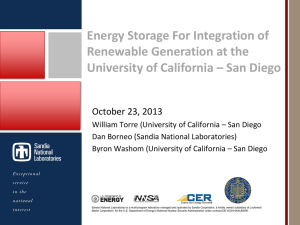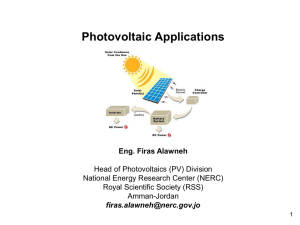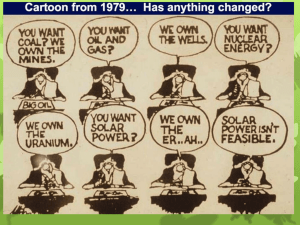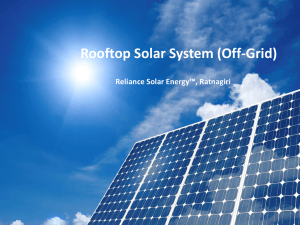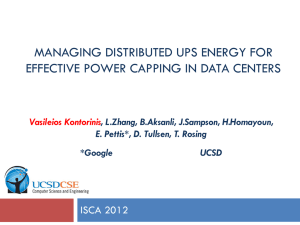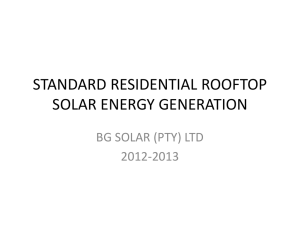View Conference Presentation - United States Association for
advertisement
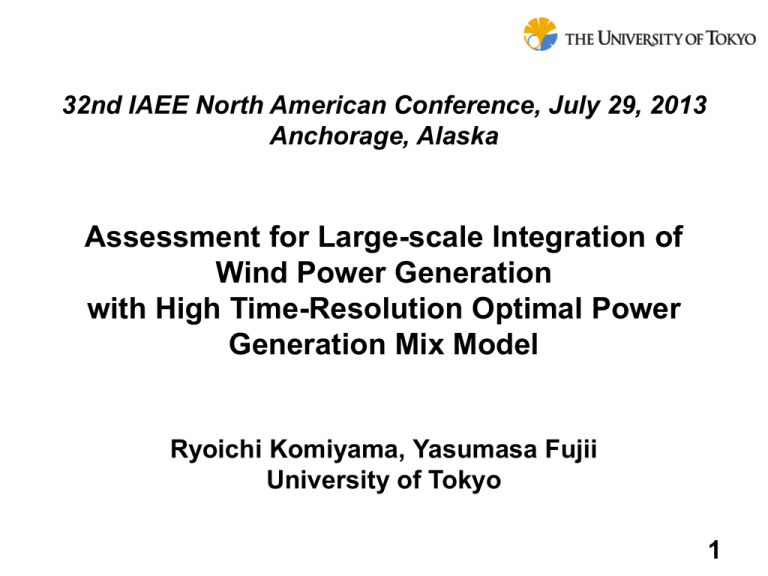
32nd IAEE North American Conference, July 29, 2013 Anchorage, Alaska Assessment for Large-scale Integration of Wind Power Generation with High Time-Resolution Optimal Power Generation Mix Model Ryoichi Komiyama, Yasumasa Fujii University of Tokyo 1 Outline Introduction Optimal Power Generation Mix Model Wind Output Estimation in Japan Results - Power Generation Mix - Optimal Dispatch - Sensitivity Analysis on Battery Cost Concluding Remarks 2 Introduction: Wind Resource Map in Japan Maximizing renewable is a key political agenda in Japan after Fukushima Onshore Offshore Hokkaido : 139.6 GW (49%) Hokkaido : 403.0 GW (26%) Tohoku : 72.6 GW (26%) Tohoku : 224.8 GW (14%) Kyushu : 20.9 GW (7.4%) Total Potential: 282.9 GW Kyushu : 454.6 GW (29%) Wind Resource Wind Speed Total Potential: 1572.6 GW (Note) Total utility capacity in Japan: 202 GW (Source) Ministry of Environment Wind Resource Wind Speed 3 Objective Maximum potential of installable wind power in Japan amounts to about 280 GW in onshore and around 1600 GW in offshore which is together equal to more than 9 times of Japan’s peak demand (around 200 GW) Thus in Japan, immense potential of wind power generation, 9 times of the peak demand, is expected to be exploited for the future This study investigates the potential of wind resource which could be systematically integrated into Japanese power generation mix, using a high time-resolution optimal power generation mix model Wind resource potential in Japan [GW] Hokkaido Tohoku Tokyo Hokuriku Chubu Kansai Chugoku Shikoku Kyushu Okinawa Total Japan Onshore Wind 140 73 4 5 8 13 9 5 21 6 283 Offshore Total Electric Power Capacity Wind 403 225 79 62 39 25 152 42 455 91 1,573 7 17 64 8 33 34 12 7 20 0.2 202 (Source) Ministry of the Environment in Japan, “Study of Potential for the Introduction of Renewable Energy(FY 2010)”, April 2011 4 High Time-Resolution Optimal Power Generation Mix Model Time-Resolution: 10 minutes in 365 days, 52,560 time segments ( = 6 time points per hour×24 hours per day×365 days per year) The model is applicable to various countries and regions other than Japan Optimal Power Generation Mix Model Objective function: Technology minimize. Annual facility cost + Annual fuel cost Constraint: • • • • • • • • • (Single period optimization) Demand and supply balances Available power plant capacity constraint Upper and lower installable capacity constraint Capacity reserve constraint for electricity supply reliability Load following capability constraint Minimum output constraint on thermal power plant Charge and discharge balances on battery technology Available power plant capacity constraint on battery technology CO2 emissions constraint ・Optimal dispatch of power generation ・Newly-building power capacity ・Power generation cost ・Fuel consumption ・CO2 emissions etc. Number of Constraints: 4.0 million Number of Endogenous Variable: 1.3 million (Source) R.Komiyama, S.Shibata, Y.Nakamura and Y.Fujii: Analysis of possible introduction of PV systems considering output power fluctuations and battery technology, employing an optimal power generation mix model, Electrical Engineering in Japan, Volume 182, Issue 2, pp.9-19 (2012) (http://onlinelibrary.wiley.com/doi/10.1002/eej.22329/abstract) • • • • • • • • • • Coal-fired Oil-fired Gas-fired Gas-CC Geothermal Nuclear Wind PV Pumped hydro Stationary NAS battery (Sodium Sulfur battery) • Stationary Li-ion battery • Suppression of PV • Suppression of Wind 5 Assumption of Cost and Technical Data Type Unit Construction Cost [$/kW] Life Time [year] Annual O&M Cost Rate Maximum Capacity [GW] Minimum Capacity [GW] Maximum Increase Rate of Output [1/hour] Maximum Decrease Rate of Output [1/hour] Conversion Efficiency Own Consumption Rate Fuel Cost [cent/specific unit] Heat Content[kcal/specific unit] Carbon Content[kg-C/specific unit] Seasonal Peak Availability Annual Average Availability Share of Daily Start and Stop Minimum Output Level Specific Unit Capacity Reserve Ratio Annual Interest Rate Fixed Asset Tax Rate Salvage Value Rate 0.08 0.03 0.014 0.1 Nuclear 3,500 40 0.04 34 GW 0 0 1 0.04 1.67 860 0 0.85 0.85 0 0.3 kWh Coal 2,300 40 0.048 ∞ 0 0.31 0.58 0.418 0.061 8.367 6139 0.61752 0.85 0.783 0 0.3 kg LNG GCC 1,200 40 0.036 ∞ 0 0.82 0.75 0.57 0.02 51.985 13043 0.7462 0.9 0.833 0.5 0.2 kg LNG ST 1,200 40 0.036 ∞ 0 0.82 0.75 0.396 0.04 51.985 13043 0.7462 0.9 0.8 0.3 0.2 kg Oil 1,900 40 0.039 ∞ 0 1 1 0.394 0.045 70.197 9126 0.78792 0.9 0.8 0.7 0.3 l Biomass 3,500 40 0.048 5.5 GW 0 0.31 0.58 0.2 0.13 12.25 3585 0 0.85 0.783 0 0.3 kg Hydro 8,500 60 0.0178 Geothermal 5,100 20 0.01 23 GW 1.2 GW PV 4,000 17 0.01 ∞ 3.6 GW Wind 2,640 17 0.02 ∞ 2.2 GW Type Unit Construction Cost [$/kW] Life Time [year] Annual O&M Cost Rate Maximum Capacity [GW] Minimum Capacity [GW] Unit Construction Cost [$/kWh] Life Time [year] Annual O&M Cost Rate Unit Consumable Material Cost [$/kWh] Life Cycle [times] Cycle Efficiency Self Discharge Loss [1/hour] Maximum kWh ratio to kW Usage Rate Advantage of NAS battery Abundant component resource (Na, S) availability High energy density (3 times as Lead) High charge and discharge efficiency Long lifetime, No self-discharge Maintenance is simple Disadvantage of NAS battery Heating system to maintain 300 degrees is required Component materials such as Na are flammable Pumped hydro Battery(NaS) 2,400 60 0.01 28 GW 10 60 0.01 0 ∞ 0.7 0.0001 6 0.9 1,200 15 0.01 ∞ 0 40 15 0.01 160 4,500 0.9 0.001 ∞ 0.9 6 Estimation of Wind Output by using Japanese Metrological Database (AMeDAS*) *Automated Meteorological Data Acquisition System Wind velocity from AMeDAS Equivalent wind velocity at hub height Wind power generation output of unit capacity Further modification of wind velocity Performance curve of wind turbine Minimum regional capacity usage rate Height of AMeDAS observation point Height of a hub of wind turbine Power law parameter Output of Wind Power Generation [kW] Wind output is estimated from data in 1,300 weather observation sites of Japan. 0 Vc 10 Vr 20 Vf 30 Wind Velocity [m/sec] Tohoku region in Dec. 2007 (Actual & estimated output) Output [MW] Real Wind Power Output Estimated Wind Power Output Day of December 2007 7 Wind output in Japan In Japan, the majority of onshore wind resources concentrate on Hokkaido and Tohoku regions (North part of Japan). The whole pattern of wind output in Japan is calculated using a weighted average of the derived regional wind power output in the amount of regional wind resources. Wind velocity is higher in winter & spring and lower in summer. Output of unit capacity[p.u.] Wind output of Japan in 365 days at 10 minutes’ interval 1 0.8 0.6 0.4 0.2 0 Day of the year Time of the day 8 PV output in Japan Time profile of PV is estimated by solar irradiance model with meteorological observation data including sunshine duration, precipitation and ambient temperature. Solar insolation intensity is higher in summer, lower in winter Annual capacity factor of PV Output of unit capacity[p.u.] PV output in 365 days at 10 minutes’ interval 1 0.8 0.6 0.4 0.2 0 Time of the day Day of the year 9 Power Generation Mix As installed wind power expands in Japan’s electricity system, wind mainly replaces thermal power generation, while the suppression control of wind power generation increases. Rechargeable NAS battery technology is not so much introduced, even in the massive penetration of wind power, mainly due to its more expensive cost compared with other measures such as the suppression control and quick load following of thermal power plant such as LNG combined cycle. Wind power integration in power generation mix becomes incrementally saturated, and the suppression control of wind power considerably increases as installed wind expands in the grid. Generation (kWh) 2500 TWh 2000 1500 Pumped(out) Suppressed Wind PV 1000 Wind LNGCC 500 Coal Nuclear 0 Pumped(in) Wind Power Capacity (Ratio to Peak Demand) 1200 Suppressed Wind Suppressed PV 1000 Battery(in) Pumped(in) 800 Battery(out) Pumped(out) Wind 600 PV Biomass 400 Oil Pumped-hydro LNG PV 200 LNG GCC Coal Coal Nuclear Nuclear 0 Hydro Geothermal Hydro Power demand GW Wind LNGCC 4.00 3.50 3.00 2.50 2.25 2.00 1.75 1.50 1.25 1.00 0.85 0.75 0.50 0.25 0.20 0.15 0.10 0.05 0.03 -500 4.00 3.50 3.00 2.50 2.25 2.00 1.75 1.50 1.25 1.00 0.85 0.75 0.50 0.25 0.20 0.15 0.10 0.05 0.03 Hydro Capacity (kW) Wind Power Capacity (Ratio to Peak Demand) Battery Pumped-hydro Wind PV Biomass Oil LNG LNG GCC Coal Nuclear Geothermal Hydro 10 Wind Integration into the Grid When wind capacity is integrated at more than a half of the scale of the peak demand or the fraction of wind power generation in total electricity demand exceeds around 20 percent, the ratio of suppressed wind power shows a significant increase On wind installed capacity at the same, double and triple of the peak demand, the ratio of suppressed output in total wind power generation shows 20%, 40% and 60% respectively. Breakdown of wind power: wind output into the grid and its suppression Wind Power Generation (Ratio to Annual Electricity Demand) 3.0 2.5 2.0 1.5 1.0 Suppression of Wind 0.5 0.2 Wind Power Generation 0.0 0.0 0.5 1.0 1.5 2.0 2.5 3.0 3.5 4.0 4.5 5.0 5.5 6.0 6.5 7.0 Wind Power Capacity (Ratio to Peak Power Demand) 11 Monthly Optimal Dispatch (May) (Wind is installed at 200GW, accounting for the same scale of peak demand, 30% of total electricity demand) Renewable variability is technically controlled by energy storage technology such as pumpedhydro, load following operation by thermal power plant and the output suppression control of wind power. A variety kind of measures dynamically function as a whole to control the shortcycle variation of wind output. In May when wind intensity is higher, elaborate suppression control is required. In August when wind intensity is lower, suppression is not required. ⇒Controlling seasonal imbalance is indispensable under massive penetration of wind power. 300 May 250 Power Generation [GW] Pumped(out) 200 LNGCC 150 100 Coal 50 PV -50 Wind Nuclear Hydro Geothermal 0 May 1 Pumped(in) May 31 250 Pumped(out) August 200 Power Generation [GW] Suppressed Wind PV 150 100 LNGCC Wind Coal 50 Nuclear 0 -50 Hydro August 1 Pumped(in) August 31 Suppressed Wind Suppressed PV Battery(in) Pumped(in) Battery(out) Pumped(out) Wind PV Oil LNG LNG GCC Biomass Coal Nuclear Geothermal Hydro Demand Suppressed Wind Suppressed PV Battery(in) Pumped(in) Battery(out) Pumped(out) Wind PV Oil LNG LNG GCC Biomass Coal Nuclear Geothermal Hydro Demand 12 Suppression Control (Curtailment) of Wind (Wind is installed at 200GW, accounting for the same scale of peak demand, 30% of total electricity demand) Suppression rate of wind in Japan tends to become higher in winter and spring seasons, because wind velocity remains higher while the level of electricity demand is modest at those seasons. By contrast, summer season reveals the lower curtailment rate due to the lower wind intensity. In May, monthly-average wind suppression rate is observed to show 80%. Time of the day Suppression Rate [%] 80-100 60-80 40-60 20-40 Day of the year 31-Dec 1-Dec 1-Nov 1-Oct 1-Sep 1-Aug 1-Jul 1-Jun 1-May 1-Apr 1-Mar 1-Feb 1-Jan 0-20 13 Load Factor of LNG Combined Cycle Load factor of LNG combined cycle goes significantly down in winter and spring season when wind velocity shows higher intensity LNGCC appears to be not profitable under massive wind penetration. Who will do investment in building LNGCC ? Time of the day Suppression Rate [%] 80-100 60-80 40-60 20-40 0-20 31Dec 1-Dec 1-Nov 1-Oct 1-Sep 1-Aug 1-Jul 1-Jun 1May 1-Apr 1-Mar 1-Feb 1-Jan Wind: 5GW Day of the year Time of the day Suppression Rate [%] Wind: 200GW 80-100 60-80 40-60 20-40 0-20 Day of the year 31Dec 1-Dec 1-Nov 1-Oct 1-Sep 1-Aug 1-Jul 1-Jun 1May 1-Apr 1-Mar 1-Feb 1-Jan (the same scale of peak demand, 30% of total electricity demand) 14 Sensitivity Analysis on Battery Cost Five cases are supposed about the battery cost. Japanese official roadmap sets a target of reducing the battery cost by 90% until 2030 from the current technical level. Sensitivity analysis of battery cost shows that lower battery cost increases the installed battery capacity and decreases the suppression control of wind power, which suggests that the reason of wind power suppression instead of storing its surplus output in the battery is attributable to the higher cost of rechargeable NAS battery. Cost scenario of rechargeable sodium-sulfur (NAS) battery Base. 1,200 40 160 4,500 Unit Facility Cost [$/kW] Unit Facility Cost [$/kWh] Unit Expendable Material Cost [$/kWh] Lifetime [cycle] -25% 900 30 120 4,875 -50% 600 20 80 5,250 -75% 300 10 40 5,625 -90% 120 4 16 6,000 Power generation 1600 1400 TWh Battery(out) Suppressed Wind 1200 Pumped(out) 1000 Wind 800 PV LNGCC Coal 600 400 Nuclear 200 Hydro 0 -200 -400 Pumped(in) Battery(in) Battery Battery - Battery - Battery - Battery base 25% 50% 75% 90% Suppressed Wind Suppressed PV Battery(in) Pumped(in) Battery(out) Pumped(out) Wind PV Biomass Oil LNG LNG GCC Coal Nuclear Geothermal Hydro Demand 15 Installed Battery Capacity As the battery cost decreases, its kWh(energy)-capacity represents more rapid growth compared with its kW-capacity. In the battery cost 90% reduction case, the ratio of kWh-capacity to kW-capacity amounts to around 30 hours, which suggests that NAS battery is introduced to charge the surplus wind power in a longer time interval, such as on a weekly basis. Preparation of sufficient energy capacity (kWh) is required for realizing a massive integration of wind power in the grid. Power capacity (kW) 100 90 80 70 60 50 40 30 20 10 0 Energy capacity (kWh) 3000 GW GWh 2500 2000 1500 1000 500 0 Battery base Battery -25% Battery -50% Battery -75% Battery -90% Battery Battery Battery Battery Battery base -25% -50% -75% -90% 16 SOC (state of charge) of Battery (Wind is installed at 300GW, accounting for 1.5 times the peak demand, 50% of total electricity demand) NAS battery is installed for storing surplus wind power chiefly in a weekly scale. Energy loss of NAS battery is huge in a weekly scale of the battery operation. Battery cost scenario: -50% (Wind: 300GW, NAS battery: 79GW/579GWh) 3000 Stored Electricity [GWh] 2500 2000 Pumped 1500 Battery 1000 Battery 500 Pumped-hydro 0 May 1 May 31 Battery cost scenario: -90% (Wind: 300GW, NAS battery: 79GW/579GWh) 3000 Stored Electricity [GWh] 2500 Battery 2000 Pumped 1500 Battery 1000 500 Pumped-hydro 0 May 1 May 31 17 Technical Compatibility between Wind and Battery Wind intermittency in Japan shows a long-cycle variation ⇒Energy loss of rechargeable NAS battery becomes larger ⇒NAS battery is less technical compatibility with wind power Wind output through a year at 10-minute interval Time of the day 8:00 PM 4:00 PM 12:00 PM Output[p.u.] 0.8-1 0.6-0.8 0.4-0.6 8:00 AM 4:00 AM 0.2-0.4 0-0.2 Day of the year 31-Dec 1-Dec 1-Nov 1-Oct 1-Sep 1-Aug 1-Jul 1-Jun 1-May 1-Apr 1-Mar 1-Feb 1-Jan 12:00 AM 18 Concluding Remarks Wind output is suppressed when it is massively integrated When wind capacity is integrated at more than a half of the scale of the peak demand or the fraction of wind power generation in total electricity demand exceeds around 20 percent, the ratio of suppressed wind power shows a significant increase (wind power is curtailed). Rechargeable battery is an expensive option Battery is too expensive to control the intermittency, and a longcycle variation of wind output prevents the massive introduction of rechargeable battery for compensating the wind variability. Reason of wind suppression is due to the high battery cost Lower battery cost increases the installed battery capacity and decreases the suppression rate of wind power, which suggests that the reason of wind power suppression instead of storing its surplus output in the battery is attributable to the high cost of NAS battery. 19 Thank you for your kind attention. Ryoichi Komiyama Associate Professor Resilience Engineering Research Center University of Tokyo komiyama@n.t.u-tokyo.ac.jp 20 (Appendix) Performance of Rechargeable Battery Energy density (Wh/kg) Energy Efficiency (%) Lifetime (cycle) Cost ($/kW) Cost ($/kWh) Lead 35 87 4,500 1,500 500 NAS 110 90 4,500 2,400 250 Ni-MH 60 90 2,000 1,000 1,000 LiB 120 95 3,500 2,000 2,000 (Source) METI “Current Situation on Battery Technology” (in Japanese), Feb. 2012 21


